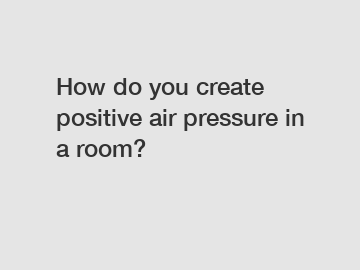How do you create positive air pressure in a room?
When it comes to creating a comfortable and healthy environment in a room, one important factor to consider is the air pressure. Positive air pressure occurs when there is more air entering a room than exiting it, creating a slight pressure differential that can help keep out pollutants, allergens, and other unwanted particles. This can be particularly important in spaces where air quality is a concern, such as hospitals, laboratories, and clean rooms. .
So, how can you create positive air pressure in a room? There are several strategies that can help achieve this goal, whether you are looking to improve indoor air quality or control ventilation in a specific area. Here are some tips to consider:
1. Use airtight seals: One of the most effective ways to create positive air pressure in a room is to ensure that the space is well-sealed. This means checking for any gaps or cracks around doors, windows, vents, and other openings where air could leak in or out. Using weatherstripping, caulking, or other sealing materials can help minimize air infiltration and maintain a positive pressure inside the room.

2. Adjust ventilation systems: Another key factor in creating positive air pressure is controlling the flow of air into and out of a room. This can be achieved by adjusting the settings on HVAC systems, exhaust fans, and other ventilation equipment to ensure that more air is being supplied than expelled. By regulating the airflow, you can maintain a consistent pressure differential that helps keep contaminants at bay.
3. Install air purifiers: In spaces where air quality is a concern, such as those with high levels of dust, pollen, or other allergens, air purifiers can be a valuable tool for creating positive air pressure. These devices use filters and other technologies to remove particles from the air, improving overall indoor air quality and helping to maintain a healthy environment.
4. Use airlocks: In facilities with strict cleanliness requirements, such as hospitals or laboratories, airlocks can be employed to create positive pressure zones that prevent contaminants from entering sensitive areas. These sealed chambers have multiple doors and ventilation systems that help control airflow and maintain a clean, controlled environment.
5. Monitor and adjust pressure levels: To ensure that positive air pressure is being maintained in a room, it is important to regularly monitor pressure levels and make adjustments as needed. This can be done using tools such as pressure gauges, manometers, or airflow sensors to track the airflow and pressure differentials in real time. By staying vigilant and proactive, you can prevent issues that could compromise air quality and safety.
Creating positive air pressure in a room is a critical aspect of indoor air quality and ventilation control. By following these tips and strategies, you can help ensure that the air in your space is clean, healthy, and safe for occupants. Whether you are looking to improve air quality in your home, office, or healthcare facility, taking steps to create positive air pressure can have a significant impact on the overall comfort and well-being of those who inhabit the space.
The company is the world’s best bed head unit hospital, clean room doors manufacturers, clean room doors supplier. We are your one-stop shop for all needs. Our staff are highly-specialized and will help you find the product you need.



Comments
0